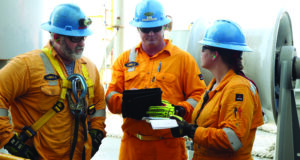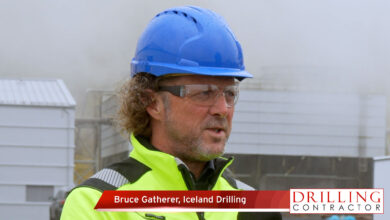Noble teams up with tech company to leverage AI, create and deploy inclusive, automated behavior-based safety program

By Adrian Brown, Fennex; Barry Quinn, Noble Corp
challenges in the oil and gas industry, leaders are seeking innovative tools and solutions that will help them remain relevant and competitive, and digital technologies are leading the charge in driving the change in modern operations. Advancements in artificial intelligence (AI), machine learning, and data analytics offer the potential to revolutionize efficiencies. This article describes how Noble Corp collaborated with tech company Fennex to harness the power of advanced digital technologies and fully automate safety observation processes across Noble’s global rig fleet, delivering benefits in efficiency, efficacy and sustainability.
With it, an outdated process with lagging indicators has been transformed into a clear, agile system providing unprecedented speed and transparency to pursue excellence in safety performance.
The digital revolution
The oil and gas industry is going through radical change, much of which is being driven by the adoption of powerful digital technologies. The sector is positioning itself to embrace a technological reorganization of its business methods and industrial processes, following the rest of the business world in the so-called “fourth industrial revolution.”
This is powered by advancements in AI, machine learning, robotics, the Internet of Things, 3D printing, quantum computing and beyond. Some of these technologies are commonplace in other sectors, but the oil and gas industry has sometimes been slower to adapt. This is a pivotal moment where the successful application of these technologies offshore is starting to show results, leading to improved project performance, production efficiency and workforce productivity. And forward-thinking industry players are set out to fully realize the significant benefits that the digital revolution can bring.
For a sector that pioneered the adoption of digital technologies in many other business areas, the oil and gas industry has yet to exploit the full potential of advanced digital ecosystems to drive transformative change in the area of health and safety. The complexity of offshore processes and management systems, as well as the diverse global workforces of international players, are obstacles. Solutions used in other sectors may be ill-equipped.
Behavior-based safety
Behavior-based safety (BBS) is not a novel concept. It can be traced to the 1930s to work done by the American industrial safety pioneer Herbert Heinrich. His research concluded that as many as 90% of all workplace incidents are directly attributable to “human error,” or the unsafe actions of workers.
By the 1970s, behavioral safety programs had grown in popularity across the United States, and other countries followed suit. In the 1980s, the British Health and Safety Executive (HSE) commissioned a number of studies aiming to cement BBS within the oil and gas industry.
BBS programs have since become a key aspect of safety management systems. This is because of its unique methods of enhancing safety culture on the ground in a way that is both straightforward to implement and based on education and alertness around safety. Key steps include elevating employees’ risk awareness and empowering workers to identify and prevent risky behaviors and unsafe conditions. If implemented fully and correctly, BBS provides team leaders with a new set of tools to unlock and explore insight into workplace safety, mitigating and preventing hazards in the long term.
However, current BBS programs used offshore often rely on outdated methods of data collection, such as paper cards and manual entry systems. Key workers are anchored at desks to do burdensome paper work or spreadsheet inputs in an inefficient system of data analysis. Ultimately, this time-consuming system cannot keep up with safety data trends, and any insights are merely lagging indicators. Workers are kept away from more critical, high-impact tasks and instead have to input and analyze data that is already outdated by the time a report can be generated.
The need for change is evident. If the burdensome BBS systems can be streamlined and digitized, a radical new efficiency can be achieved.
Challenging the status quo
Through its partnership with Fennex, Noble has successfully implemented data-driven bespoke technologies, thus digitizing and automating critical performance business systems, improving its operational productivity and enhancing its performance consistency.
In 2020, the two companies discussed ways to improve HSE performance and safety culture across Noble’s global offshore fleet, and the decision was made to digitize its corporate BBS program. This was recognized as a challenging undertaking that would require in-depth analysis and understanding of each stage in the safety processes.
The task was to design a system that was accessible to all workers – totally inclusive. In addition, the solution needed to meet the key objectives of using automated reporting and notification systems and providing transparent, visible and meaningful data analysis to enhance collaboration and accelerate decision making.
Changing any established system, especially one that involves a diverse global workforce across geographic and linguistic divides and directly affects people’s safety, comes with risks. If key factors, including accessibility and adaptability, are not addressed, the change can be an agonizing process at best or, at worst, a total failure. To successfully transform this people-led safety program, the Fennex team needed to ensure that its digital solution would be built correctly, with a focus on the end objectives and user experience.
BBSS: an industry-first solution
Following successful collaboration with Noble’s HSE and IT teams, Fennex developed a cloud-based, intuitive digital solution: Behavioral-Based Safety Solution (BBSS), bespoke and branded to Noble’s unique safety system. It was referred to as the 3COT solution.
BBSS /3COT fully automates and digitizes the end-to-end safety observations program across Noble’s fleet. This is the first technology in the offshore industry that is powered by AI technologies to combine physical and digital observation data entries, allowing a seamless scale-up deployment and full adoption across global operations simultaneously, regardless of digital readiness or the geographic location of operation. This has been mainly achieved by engineering a solution that standardizes the safety data source to streamline into a cloud-based technology. This then allows in-depth insights and access to reports and actionable times in real time.
One of the biggest challenges faced by international companies in the digitization process is the variance in digital readiness of the workforce itself. The problem comes down to the fact that not all workers have access to the digital tools required for a sufficient level of data collection to digitize the work process.
The design of the BBSS technology allows easy safety-observation data input from three source types: mobile apps, web-based forms and paper-based cards. The mobile app leverages QR codes, unique to each site or offshore installation, to optimize both online and offline data sourcing. By scanning the code, the user can upload an entry about the safety observation of the location in seconds. As such, at-risk or unsafe behaviors and conditions, as well as positive observations, can be captured and reported anywhere and at any time, improving worker engagement.
However, relying only on web forms or app-based platforms wouldn’t allow for an all-inclusive sourcing of data. This is where the paper-based cards come in to ensure full participation from workers, regardless of access to digital tools. The paper-based cards were designed in line with Noble’s specific format in terms of risk identification, classification and reporting. This allows them to be converted into digital data directly at the scanning point.
Unsupervised machine learning algorithms are able to distinguish and extract the text, key and value pairs from the scanned form documents, providing optimum accuracy of data input. These features have proven crucial for a seamless, simultaneous deployment and adoption across global operations, while maintaining inclusivity and applicability regardless of the digital readiness of the location of operation.
So far, the BBSS digital solution has hit three key targets. Firstly, it provided a data collection system that can be easily accessed by all users, from customers to third-party associates. Secondly, it streamlined and standardized the data capture, laying a strong foundation for automated cloud-based data processing at an enterprise scale in a way that is agile and aligned with company HSE branding and classification. Thirdly, while the system allows for paper input, it also provides the tools for a digital transition down the line, aiming for a sustainable, paperless process.
However, there remained a significant obstacle in data collection that needed to be solved in order to reap the benefits mentioned above: the language barrier. Language barriers remain one of the most persistent problems of safety reporting. Without innovation, this issue is unlikely to solve itself in the global energy market. In fact, reports by the UK HSE cite language as one of the biggest barriers for concise and effective safety and risk reporting.
Additionally, within organizations that operate in international markets, this reporting is often conducted in the worker’s first language. At the same time, depending on the region of operations, there may be a regulatory or customer-driven need to adopt a different language. How, then, can companies help to clearly communicate important safety and risk issues and prevent it from getting lost in translation?
This is where AI and machine learning enter. Over the past decade, the advancement of AI coupled with the accuracy and quality of machine translation has significantly improved translation capabilities between languages. To engineer the solution for global deployment, the design of BBSS included capture, processing and analysis of all safety and risk entries in 30-plus languages.
An AI feature first detects the language of data entry, then translates the text to English, allowing for data analysis and insight assessment across the organization. This means that safety data entries can be done in the language that the user prefers, which is especially beneficial for workers who might struggle to articulate safety observations in English.
By leveraging AI to streamline multilingual safety reporting, Fennex focused on constructing a tool that enables more effective communication and reporting of safety risks on an international scale. The BBSS platform maximizes the worker engagement and collaboration by reducing local language barriers and allowing users to engage in their preferred language.
The application of AI and new technologies goes well beyond language translation. It also allows for a streamlining of the workflow and reporting at a more rapid, automated scale, removing operational lags. Data matching AI technology are leveraged for high-resolution data mapping and quality control, and robotic processing automation was heavily applied to automate report generation and overall workflow.
Bespoke algorithms, combined with the overall cloud architecture, ensure consistent outputs of accurate safety reporting. The platform allows for live data processing and streaming, with real-time monitoring of critical safety trends and indicators. The insights gained from these metrics provide clear, actionable tasks, leading to quicker decision making. The helps to mitigate risks and prevent hazards and, ultimately, will enhance people’s safety.
Results
The benefits of all these applications rest on three points: a simplified and streamlined process, quick and accurate access to critical safety data, and a secure and scalable processing of BBS observations and analytics. The BBSS technology can be adopted rapidly at a large scale, as shown in the case of Noble, which was able to fully deploy the digital solution across 20-plus offshore assets in less than 12 weeks from the start of the design.
Since its deployment six months ago, Noble has received 350,000 safety observations through the BBSS/3COT solution, representing a 30% increase in safety reporting and indicating a clear boost in engagement by the workforce. By automating routine tasks, Noble has saved an estimated 15,000 hours of labor that would have been required without the digital tools. This translates to a 70% cost reduction and savings of $1 million annually. In terms of environmental sustainability, an estimated 500,000 paper cards were saved by the shift to digitized data collection.
The digital revolution will continue changing the oil and gas sector as the industry moves into a high-efficiency future. The BBSS technology is the blue-print project that defines the digital future of the safety observation process, and it demonstrates the significant efficiencies that are realized through agile, scalable and smart digital innovations that can drive excellence in safety performance. DC
BBSS is a trademark of Fennex.
This article is based on a presentation at the 2021 IADC HSE & Sustainability Europe Conference, 15-16 September.




